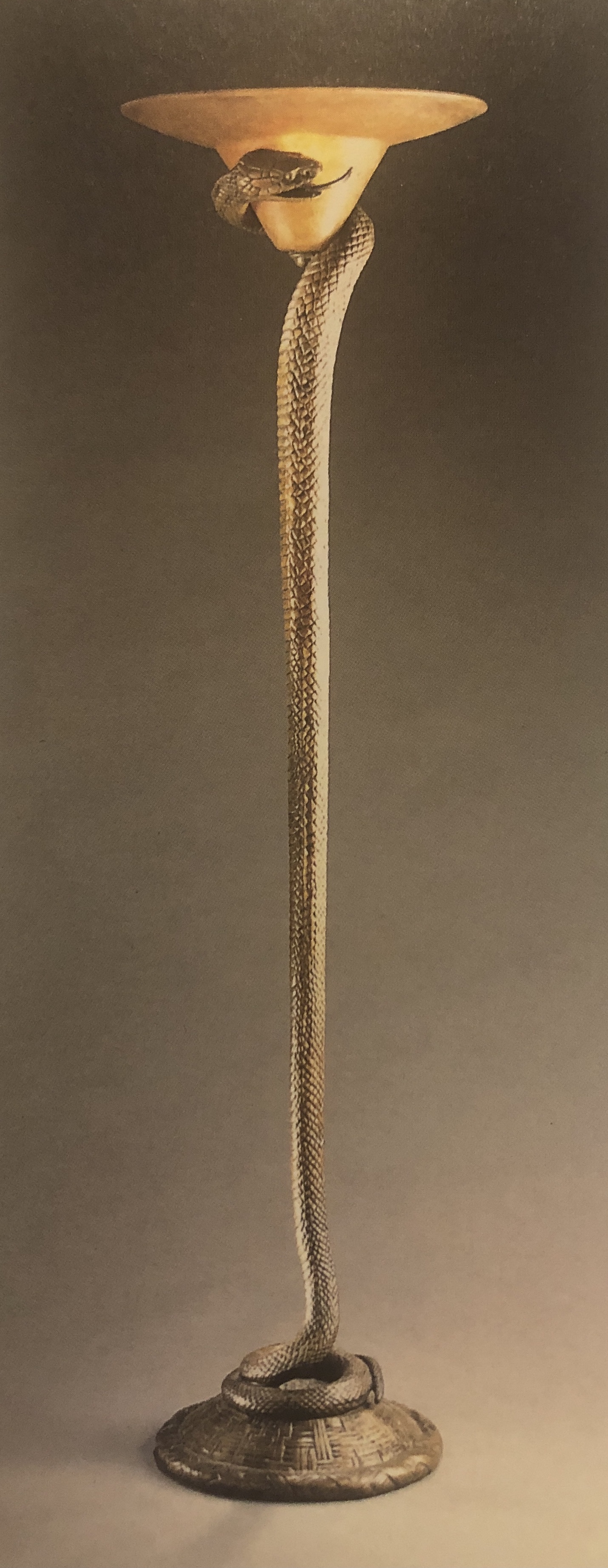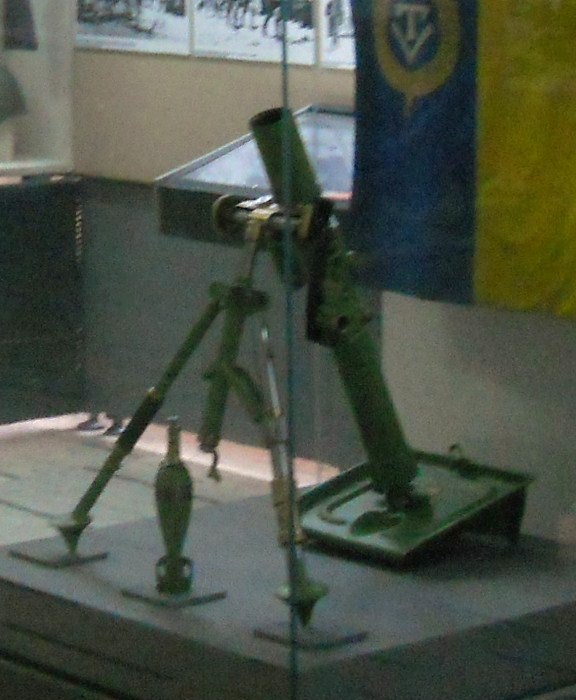|
Edgar Brandt
Edgar William Brandt (24 December 1880 – 8 May 1960) was a French ironworker and prolific weapons designer. In 1901 he set up a small workshop at 76 rue Michel-Ange in the 16th arrondissement in Paris, where he began designing, silversmithing, and forging small items such as jewelry, crosses, and brooches. His business began to take off with special commissions such as the door of the French Embassy in Brussels, the Escalier Mollien stairs in the Louvre, and the stair and balcony railing for the Grand Theatre Municipal de Nancy. At the start of World War I in 1914 Brandt was called to serve. Observing a need for mortars in trench warfare, he designed 60mm, 81mm and 120mm versions that were very widely copied throughout and subsequent to World War II. He also invented discarding-sabot artillery shells and contributed substantially to the development of effective HEAT-warhead weapons for infantry anti-tank use through his development of heatrifle grenades. Following the war Bran ... [...More Info...] [...Related Items...] OR: [Wikipedia] [Google] [Baidu] |
Mortar (weapon)
A mortar is usually a simple, lightweight, man-portable, muzzle-loaded weapon, consisting of a smooth-bore (although some models use a rifled barrel) metal tube fixed to a base plate (to spread out the recoil) with a lightweight bipod mount and a sight. They launch explosive shells (technically called bombs) in high-arcing ballistic trajectories. Mortars are typically used as indirect fire weapons for close fire support with a variety of ammunition. History Mortars have been used for hundreds of years. The earliest mortars were used in Korea in a 1413 naval battle when Korean gunsmiths developed the ''wan'gu'' (gourd-shaped mortar) (완구, 碗口). The earliest version of the ''wan'gu'' dates back to 1407. Choi Hae-san (최해산, 崔海山) (1380–1443), the son of Choe Mu-seon (최무선, 崔茂宣) (1325–1395), is generally credited with inventing the ''wan'gu''. In the Ming dynasty, general Qi Jiguang recorded the use of a mini cannon called the Hu dun pao that ... [...More Info...] [...Related Items...] OR: [Wikipedia] [Google] [Baidu] |
Brandt 60 Mm LR Gun-mortar
The Brandt 60 mm Long Range gun-mortar is a breech loading mortar capable of firing on a flat trajectory. It was developed from the Brandt Mle CM60A1 and resembles a long-barrelled, long-ranged variant of that weapon. Description The Brandt 60mm LR gun-mortar was developed directly from the Brandt Mle CM60A1 and retains the same falling block breech mechanism reminiscent of direct fire artillery.African Defence Journal, Issues 17–28'. The Journal, 1982, Collected Issues 17–28. p. 44. The firing pin is automatically withdrawn when the breech is unlocked, reducing the potential for misfire. Like its predecessor, it can be either muzzle-loaded or breech-loaded and was designed to be mounted in the turrets of armored fighting vehicles. The LR gun-mortar was also tested as a deck-mounted support weapon for maritime patrol craft such as the VCSM. It utilizes a hydraulic recoil system. The recoil length is 170mm, maximum recoil thrust is 2,800kg, and the weight of the recoili ... [...More Info...] [...Related Items...] OR: [Wikipedia] [Google] [Baidu] |
1960 Deaths
Year 196 ( CXCVI) was a leap year starting on Thursday (link will display the full calendar) of the Julian calendar. At the time, it was known as the Year of the Consulship of Dexter and Messalla (or, less frequently, year 949 '' Ab urbe condita''). The denomination 196 for this year has been used since the early medieval period, when the Anno Domini calendar era became the prevalent method in Europe for naming years. Events By place Roman Empire * Emperor Septimius Severus attempts to assassinate Clodius Albinus but fails, causing Albinus to retaliate militarily. * Emperor Septimius Severus captures and sacks Byzantium; the city is rebuilt and regains its previous prosperity. * In order to assure the support of the Roman legion in Germany on his march to Rome, Clodius Albinus is declared Augustus by his army while crossing Gaul. * Hadrian's wall in Britain is partially destroyed. China * First year of the '' Jian'an era of the Chinese Han Dynasty. * Emperor Xia ... [...More Info...] [...Related Items...] OR: [Wikipedia] [Google] [Baidu] |
1880 Births
Year 188 (CLXXXVIII) was a leap year starting on Monday of the Julian calendar. At the time, it was known in the Roman Empire as the Year of the Consulship of Fuscianus and Silanus (or, less frequently, year 941 ''Ab urbe condita''). The denomination 188 for this year has been used since the early medieval period, when the Anno Domini calendar era became the prevalent method in Europe for naming years. Events By place Roman Empire * Publius Helvius Pertinax becomes pro-consul of Africa from 188 to 189. Japan * Queen Himiko (or Shingi Waō) begins her reign in Japan (until 248). Births * April 4 – Caracalla (or Antoninus), Roman emperor (d. 217) * Lu Ji (or Gongji), Chinese official and politician (d. 219) * Sun Shao, Chinese general of the Eastern Wu state (d. 241) Deaths * March 17 – Julian, pope and patriarch of Alexandria * Fa Zhen (or Gaoqing), Chinese scholar (b. AD 100) * Lucius Antistius Burrus, Roman politician (executed) * Ma ... [...More Info...] [...Related Items...] OR: [Wikipedia] [Google] [Baidu] |
Mortier 120mm Rayé Tracté Modèle F1
The MO-120 RT (factory designator) or MO-120-RT is a French heavy mortar. The RT in the designator stands for ''rayé, tracté'', which means rifled, towed. The MO-120-RT is currently used by the French Army (where it is known as RT F1 or Mortier de 120mm Rayé Tracté Modèle F1—"120 mm rifled towed mortar, model F1"), and has also been exported to more than 24 foreign countries or in some cases, produced under licence. It is issued to artillery units, where it complements artillery guns and systems; although infantry units operate it in some countries. A vehicle-mounted and automated mortar system derived from the MO-120 RT, known as the 2R2M is in service with a number of nations. Design The MO-120 RT uses standard NATO rounds with a range of 8,2 km and the PRPA (RAP-Rocket Assisted Projectile) with a range of 13 km. The weapon can be fired either by dropping the round down the tube (after aligning of the rifling bands) resulting in an automatic firing once the ... [...More Info...] [...Related Items...] OR: [Wikipedia] [Google] [Baidu] |
Brandt Mle 1935
The Brandt Mle 1935 60-mm mortar (french: Mortier de 60 mm Mle 1935) was a company-level indirect-fire weapon of the French army during the Second World War. Designed by Edgar Brandt, it was copied by other countries, such as the United States and China, as well as purchased and built by Romania. Modified in 1944, the mortar continued to be used by France after the war until at least the 1960s. Description The Brandt Mle 1935 was a simple and effective weapon, consisting of a smoothbore metal tube fixed to a base plate (to absorb recoil), with a lightweight bipod mount. The team of the Mle 1935 was made of five men: a leader, a firer, an artificer and two suppliers. When a mortar bomb was dropped into the tube, an impact-sensitive primer in the base of the bomb would make contact with a firing pin at the base of the tube, and detonate, igniting a gunpowder charge, which would propel the bomb out of the tube, and towards the target. HE mortar bombs fired by the weapon weighed ... [...More Info...] [...Related Items...] OR: [Wikipedia] [Google] [Baidu] |
Brandt Mle CM60A1
The Brandt Mle CM60A1, also known as the ''Brandt HB 60LP'', ''MCB-60 HB'', or simply as the Brandt 60mm LP Gun-Mortar,Interconair Armies & Weapons, Collected Issues 40-49'. Interconair Media Group, 1978 p. 45-60. is a 60 mm (2.36 in.) gun-mortar. Unlike conventional infantry mortars, it was not designed to be mounted on a bipod and a baseplate, but rather in the turrets of armoured fighting vehicles. The CM60A1 could be fired at a very low angle of elevation, giving it the dual purpose of direct fire artillery. Its hydraulic recoil mechanism reduces peak loads, allowing it to be mounted in very light armoured cars, such as the Panhard AML-60, or wheeled armoured personnel carriers, like the Panhard M3. Development history The Brandt Mle CM60A1 was developed as a result of French counter-insurgency experiences during the Algerian War.Ogorkiewicz, R. M. ''AFV Weapons Profile 039 Panhard Armoured Cars'' (Windsor, Berks: Profile Publications). France had initially favoured the deploy ... [...More Info...] [...Related Items...] OR: [Wikipedia] [Google] [Baidu] |
Trench Warfare
Trench warfare is a type of land warfare using occupied lines largely comprising military trenches, in which troops are well-protected from the enemy's small arms fire and are substantially sheltered from artillery. Trench warfare became archetypically associated with World War I (1914–1918), when the Race to the Sea rapidly expanded trench use on the Western Front starting in September 1914.. Trench warfare proliferated when a revolution in firepower was not matched by similar advances in mobility, resulting in a grueling form of warfare in which the defender held the advantage. On the Western Front in 1914–1918, both sides constructed elaborate trench, underground, and dugout systems opposing each other along a front, protected from assault by barbed wire. The area between opposing trench lines (known as "no man's land") was fully exposed to artillery fire from both sides. Attacks, even if successful, often sustained severe casualties. The development of armoured ... [...More Info...] [...Related Items...] OR: [Wikipedia] [Google] [Baidu] |




